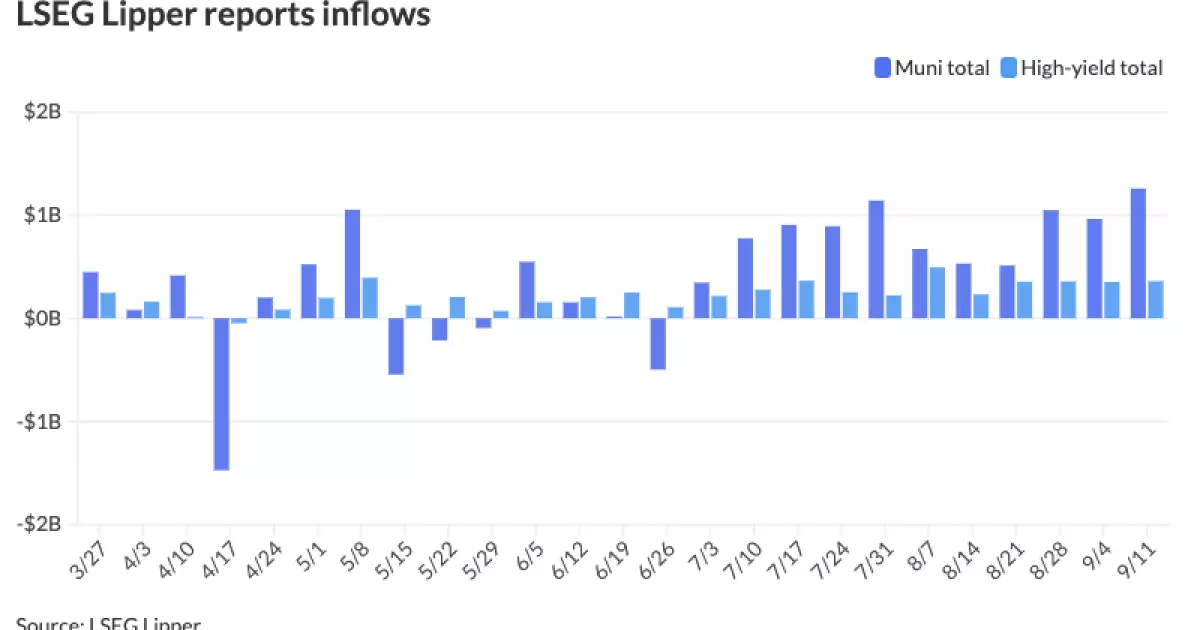Current Trends in the Municipal Bond Market: Insights and Implications

The municipal bond market has demonstrated a noteworthy resilience against the backdrop of fluctuating interest rates and shifting investor sentiments. Recent trends reveal a marked change in municipal bond mutual fund inflows alongside fluctuations in U.S. Treasuries and equity markets. This article delves into the intricate dynamics of the municipal bond landscape, assessing the implications of current trends for investors and stakeholders.
As reported, municipal bond mutual funds have recently experienced inflows exceeding $1 billion, the second largest recorded in the current year. This wave of investment follows a net inflow of $963 million in the preceding week, as highlighted by LSEG Lipper analytics. Not only does this indicate a revitalized interest in municipal bonds, but it also brings attention to the strength of the high-yield sector, with $360.2 million of inflows reported.
The sustained inflow streak, now extending to 11 consecutive weeks, signifies a shift in investor confidence. The previous years observed a staggering outflow of approximately $122 billion from the municipal market, characterized as the largest in the sector’s history, particularly during the Federal Reserve’s rate hikes commencing in Q1 2022. However, the current influx appears to be motivated by attractive nominal income opportunities, enticing a demographic of investors back to the municipal asset class, as opined by industry experts such as Sam Weitzman from Western Asset Management.
The performance metrics for municipal bonds, particularly when juxtaposed against U.S. Treasuries, reveal a fascinating interplay. Historical data indicates that previous inflow cycles of munis have rendered an average return of 12.4%. In contrast, the Bloomberg Municipal Bond Index has endured a negative performance of -2.0% over a comparable period, suggesting that the current inflow cycle remains relatively subdued compared to previous surges.
Weitzman articulates a cautious optimism, noting that the inflows witnessed thus far are still trailing behind historical averages. This inconsistency hints at an potential upside for municipal valuations moving forward, particularly if the Federal Reserve begins a new easing cycle soon. Thus, there remains a compelling narrative around value generation within the municipal space as demand begins to shift.
The ongoing struggle between supply and demand within the municipal bond market also poses interesting considerations. As issuers accelerate their bond offerings in anticipation of the upcoming November elections, some analysts predict an increase in volatility in the latter part of the year. Despite this potential surge in issuance, there are triggers that could maintain balance in the market.
Proctor from SS&C ALPS Advisors emphasizes that even with the anticipated increase in supply—occasioned by issuers seeking to fund critical infrastructure projects amid dwindling federal assistance—the supply-demand dynamics appear to be stabilizing. With calculated pricing strategies and larger deals entering the pipeline, the allure of higher yields could entice investors, keeping overall valuations relatively resilient.
The current yield curve in the municipal bond space further illustrates the complexity of these investments. Notably, ratios between municipal bonds and U.S. Treasuries provide insights into valuation perspectives. As reported, the ratios for various durations hover at attractive levels compared to both high-grade and BBB-rated corporate bonds, creating a tantalizing option for risk-conscious investors.
Keen observers have noted the municipal-to-Treasury yield ratios ranging from approximately 64% for two-year bonds to 88% for 30-year bonds. This assessment suggests that while ratios are not at their most favorable levels, the current offerings still present a competitive edge compared to several taxable alternatives in the market.
With new financing needs emerging due to infrastructure demands and changing fiscal conditions, the municipal market presents a promising landscape for savvy investors prepared to navigate potential headwinds. Proctor underscores the continued attractiveness of municipal bonds, particularly 30-year AA tax-exempt offerings that remain appealing against their corporate counterparts.
Investors remain advised to carefully weigh the current market conditions, considering the implications of potential Federal Reserve policy changes, ongoing supply pressures, and evolving yield dynamics. The coming months will likely shed further light on how these factors interplay, potentially shaping the future trajectory of investment opportunities within the municipal bond sector.
The resilience demonstrated by the municipal bond market—amidst historical outflows and recent inflows—highlights the adaptability and strategic importance of this asset class. Investors seeking value and stability are poised to benefit as the market evolves, navigating through the complexity of changing market landscapes.





